|
1954
|
Senate committee reports on Canberra
|
|
| |
The Senate appoints a Select Committee in 1954 to inquire into and report on the development of Canberra.
The committee report, published in September 1955, notes that 'Canberra as a city is being built to a plan which looks centuries ahead'. However it notes that, since the Public Works Committee enquiry of 1923, 'there seems to have been very little thought in regard to Capital Hill':
Burley Griffin's plan for this area provided for a "Capitol" on the summit, with residences for the Governor-General on the one side, and the Prime Minister on the other. Parliament House was to be on a lower level at the head of the Government Triangle on the site known as "Camp Hill", in direct line with the axis running from the "Capitol" to the summit of Mt. Ainslie….No development has taken place in regard to this area, except for the provision of temporary workmen's quarters and the laying of the foundation stones of the commencement column in 1913, and it appears in the centre of Canberra as a huge vacuum. [1]
It recommends that 'the permanent Parliament House should not be constructed on Camp Hill where Griffin intended, but on Capital Hill on the site allotted to the "Capitol"', noting that Griffin himself had considered such an alternative. The Committee agrees with the former Prime Minister the Rt Hon. WM Hughes' view that Capital Hill, with its dominating views of the city, should be the 'most prominent architectural feature in the lay-out of the city':
Having regard to the architectural features of Rome, Athens, Washington, and all the other great capital cities of the world, the most important building in Canberra should be that in which Parliament sits….Therefore the dominating site at Canberra should be utilized for Parliament House. [2]
The Committee notes that modern earth moving equipment has removed the difficulties cited in earlier criticisms of the site. Pending development of the area, the Committee recommends tree planting and landscape treatment to make Capital Hill more attractive. It also recommends the establishment of the National Capital Development Commission, which is subsequently created in 1958.
|
|
|
1957
|
Holford's lakeshore Parliament House
|
|
| |
The Menzies Government commissions British architect and town planner, Baron William Holford, to report on the planning and development of Canberra.
Holford presents his Observations on the future of Canberra to the Australian Parliament. His report is supported by the Senate Select Committee, which endorses the concept of a 'park like landscape…in the heart of Canberra, in which monumental buildings functioned both as symbols of government and of Australian unity'. His report also recommends that:
- a permanent Parliament House be built on the banks of Lake Burley Griffin rather than on Capital Hill
- the Land Axis is 'too long and too uneventful to register any marked impression on the beholder', while a lakeshore Parliament House will define the centre of the Land Axis rather than being located at one end of it where it would be 'symbolically and actually out of place'
- the Parliament, as a democratic institution, should be located among the people, rather than on top of a hill, and
- Capital Hill should be reserved as the site of a Royal Pavilion. [3]
|
|
| 1957 |
National Capital Development Commission
|
|
| |
The National Capital Development Commission is established by an Act of Parliament and begins operations in 1958 under Commissioner John Overall. The NCDC assumes responsibility for the planning and development of Canberra including Lake Burley Griffin, Parliament House and the new towns of Woden Valley, Weston Creek, Belconnen, Tuggeranong and Gungahlin. It retains responsibility for planning, construction and urban development in Canberra until 1989. Sir John Overall heads the organisation until 1972.
|
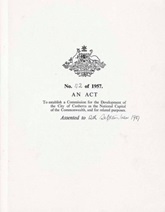
National Capital Development Commission Act 1957
Image courtesy of National Archives of Australia
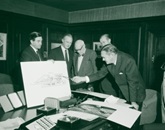
Sir John Overall, Robin Boyd, Sir Daryl Lindsay, Mr Peter Nixon and Mr John Gorton look at the plan for the new National Gallery in Canberra, Australian News and Information Bureau
Image courtesy of National Archives of Australia
|
|
1959
|
Holford plan approved
|
|
| |
In May 1959 the federal Cabinet approves Holford's plan for the centre of Canberra which includes the development of Parliament House on the banks of Lake Burley Griffin rather than on Capital Hill. Work commences on aspects of Holford's plan. On 10 March 1962 Prime Minister Robert Menzies officially opens Kings Avenue Bridge, and the Scrivener Dam is completed in September 1963, allowing the waters of the Molonglo River to form Lake Burley Griffin [4]
|
|
|
1960
|
Parliamentary Library separates from National Library of Australia
|
|
| |
With the passage of the National Library Act 1960, the Parliamentary Library and the National Library of Australia are formally separated and the National Library of Australia moves into its own building in August 1968 whilst the Parliamentary Library remains in the Provisional Parliament House to continue serving the Parliament and moves to the permanent Parliament House in 1988.
The Commonwealth Parliamentary Library was originally established in 1901 to serve both Commonwealth Parliament and the nation. The Joint Parliamentary Library Committee responsible for establishing the Parliamentary Library stated its objective as:
…keeping before it the ideal of building up, for the time when Parliament shall be established in the Federal Capital, a great Public Library on the lines of the world-famed Library of Congress at Washington; such a library, indeed, as shall be worthy of the Australian Nation; the home of the literature, not of a State, or of a period, but of the world, and of all time. [5]
In 1927 the Library was relocated with the Parliament from Melbourne to Canberra.
|
|
|
1963
|
Yirrkala Bark Petitions
|
|
| |
The Yolngu people of Arnhem Land in the Northern Territory send two bark petitions known as the Yirrkala Bark Petitions to the Commonwealth Parliament.
The Yolngu prepare the petitions in response to the Government's removal of more than 300 square kilometres of their land in Arnhem Land, Northern Territory, to enable bauxite to be mined. A parliamentary committee of inquiry acknowledges the rights of Yolngu as set out in the petitions, and recommends to Parliament that compensation be paid for loss of livelihood, that sacred sites be protected, and that an ongoing parliamentary committee monitor the mining project. The petitioners turn to the Supreme Court in the Northern Territory but their case also fails to achieve their objective. Whilst they are not the first claims to be made by Indigenous groups, the Yirrkala bark petitions are the first traditional documents to be recognised by the Commonwealth Parliament and, as such, they represent documentary recognition of Indigenous people in Australian law. The Yirrkala Petitions are subsequently displayed to the public in the permanent Parliament House after the permanent Parliament House opens in 1988. [6]
|
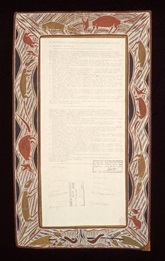
Yirrkala artists, Dhuwa moiety. Yirrkala Bark Petition 14.8.1963, 46.9 x 21 cm, natural ochres on bark, ink on paper
Image courtesy of Parliament House Art Collection, Canberra ACT
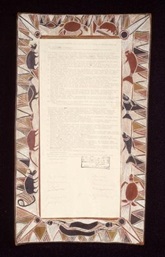
Yirrkala artists, Yirritja moiety, Yirrkala Bark Petition 28.8.1963, 46.9 x 21 cm, natural ochres on bark, ink on paper
Image courtesy of Parliament House Art Collection, Canberra ACT
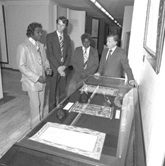
Yolngu leaders Gallarwuy Yunupingu (left) and Silas Roberts at Parliament House in 1977 with Jeremy Long and the Minister for Aboriginal Affairs, THE Hon. Ian Viner (right), looking at the two bark petitions presented to the House of Representatives in 1963.
Image courtesy of National Archives of Australia
|
|
1965
|
Permanent Parliament House inquiry
|
|
| |
The Parliament establishes a Joint Select Committee to inquire into 'certain aspects of a new and permanent Parliament House'. The Joint Select Committee receives a large number of submissions and undertakes a study tour of overseas parliament buildings. Its final report is produced in April 1970. [7]
|
|
| 1966 |
Full voting rights for the ACT
|
|
| |
In 1966, full voting rights are conferred on the Member for the Australian Capital Territory by the Australian Capital Territory Representation Act 1966.
|
|
|
1968
|
Capital Hill versus lakeside
|
|
| |
On 15 August 1968 Prime Minister the Rt Hon. John Gorton (LP, Senator for Victoria, 1949‒68 and Member for Higgins, Vic., 1968‒75) moves:
That this House is of the opinion that the new and permanent Parliament House should be situated on the lakeside site. [8]
Gordon Bryant (ALP, Member for Wills, Vic., 1955‒80) moves an amendment to omit the words 'lakeside site' and replace them with 'Capital Hill'. [9] Debate resumes on 20 August and the vote is lost. On 27 August the Senate transmits a Resolution to the House of Representatives that 'it is of the opinion that the new and permanent Parliament House should be situated on Capital Hill'. [10] Debate is resumed again on 17 October and the vote is again lost. [11] On 26 November the Acting Speaker announces that the matter of alternative sites for the permanent Parliament House be referred to the Joint Select Committee on the New and Permanent Parliament House to report in three months. [12]
|
|
|
1968
|
Nhulunbuy bark petition
|
|
| |
A bark petition is tabled in the House of Representatives on 8 October 1968. The petition, signed by sixteen men and one woman, is attached to the back of the bark in which they asked that the town be named Nhulunbuy. [13]
|
|
|
1969
|
Camp Hill site selected
|
|
| |
On 30 April 1969, the Joint Select Committee on the New and Permanent Parliament House submits its report on the alternative sites of Capital Hill and the Camp Hill area to Parliament. [14]
The report attracts a lengthy debate in both Houses and, in a rare free non-party vote, Senators and Members decide against the proposal for a lakeside site and it is abandoned. The Joint Select Committee subsequently recommends to Parliament that the New and Permanent Parliament House should be sited at Camp Hill, as originally recommended by Walter Burley Griffin. [15] The House of Representatives votes to agree with the recommendation, whilst the Senate votes to disagree with it. The Senate also votes against a joint sitting, and the situation remains unresolved. Prime Minister the Rt Hon. John Gorton (LP, Senator for Victoria, 1949‒68 and Member for Higgins, Vic., 1968‒75) makes a ministerial statement, stating that the position cannot be allowed to remain unresolved because of the need for planning and construction to commence. He states:
The Government, therefore, feeling that a decision must be made, had decided to inform the National Capital Development Commission that Camp Hill would be the site of the new Parliament House. [16]
|
|
|
1970
|
Architectural design competition
|
|
| |
The Joint Select Committee on the New and Permanent Parliament House submits a comprehensive statement of the Parliament's requirements in a new building, which forms the basis for the Brief for the Architectural Design Competition prepared for the Parliament House Construction Authority by the National Capital Development Commission , in consultation with the Parliament and approved by the JSC.
The National Capital Development Commission was established in 1958 to plan, develop and construct Canberra as Australia's national capital. Preparation of the design brief is a complex and protracted task taking more than two years. It includes information about the site and operations of the Parliament, and its quality, accuracy and completeness is widely acknowledged and used as a guide for other important public projects in Australia and overseas. [17]
|
|
|
1971
|
Lakeside proposal abandoned
|
|
| |
The proposal to build a lakeside parliament house is abandoned, and the National Capital Development Commission draws up new plans for a 'National Place' based on a vast plaza stretching from the proposed Parliament House on Camp Hill to the southern shore of Lake Burley Griffin, flanked by national buildings.
The plan requires the demolition of the provisional (Old) Parliament House. The federal Cabinet rejects the National Capital Development Commission plan, seeking a more open vista with fewer buildings.
|
|
|
1972
|
Aboriginal Tent Embassy
|
|
| |
On Australia Day 1972, Aboriginal people establish a 'Tent Embassy' on the lawns in front of the provisional Parliament House in response to a policy statement by Prime Minister the Rt Hon. William McMahon (LP, Member for Lowe, NSW, 1949‒82) announcing a new form of lease for Aboriginal people.
The Embassy's location opposite the provisional Parliament House is controversial. It is removed and re-established several times until 1975. A second tent embassy is established on Australia Day 1992-the 20th anniversary of the first Embassy-after the Parliament passes the first federal land rights law. It continues to be a focus for Aboriginal protest in the Parliamentary Triangle to the present day. [18]
|

Aboriginal Tent Embassy outside Parliament House, Canberra, 1974
Image courtesy of National Archives of Australia
|
|
1972
|
Capital Hill site petition
|
|
| |
Gordon Bryant (ALP, Member for Wills, Vic., 1955‒80) organises a petition to the House of Representatives on 17 May 1972, calling on the Speaker and Members to support the 1955 report of the Senate Select Committee recommending that the site of the permanent Parliament House be on Capital Hill.
Clyde Cameron (ALP, Member for Hindmarsh, SA, 1949‒80) recalls a speech he gave to the House on 17 October 1973:
I again spoke in favour of Capital Hill as being the one site that would not result in the demolition of what is now called Old Parliament House. I added to my earlier list of those who had walked and talked and thought in its chambers and its libraries, starting with Bruce and ending with Whitlam. I then said 'This is a building in which future historians will give anything to stand in the place where stood these great men.' I said we should occupy Capital Hill and not leave it for future bureaucrats to be sitting there looking down on the Parliament. [19]
|
|
|
1974
|
Capital Hill site confirmed
|
|
| |
Following a protracted debate about the site for the new building, theParliament Act 1974 defines the Parliamentary Zone and confirms Capital Hill as the site for the permanent Parliament House. As architectural historian Andrew Hutson notes in his 2011 Senate Occasional Lecture:
The process for selecting an appropriate site for a new and permanent Parliament House (NPH) was complex, lengthy and involved arguments over a number of decades on the merits of a range of potential locations within the parliamentary triangle. The final location would need to balance the history and status of the Griffin plan, the ambitions of parliamentarians and the sensitivities of a wary Australian public. [20]
|
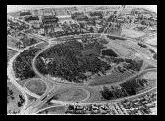
Capital Hill and State Circle
Image courtesy of ACT Heritage Library, Canberra Times Collection
|
| 1974 |
Parliamentary representation for the ACT |
|
| |
The passage of the Senate (Representation of Territories) Act 1973 provides for the representation of the ACT, NT and the Jervis Bay Territory in the Senate. The legislation proves controversial. The Bill is cited as one of the grounds for the Parliament’s double dissolution in 1974 and, having been passed in a joint sitting later that year, survives two challenges in the High Court.[21]
The Australian Capital Territory (House of Representatives) Act 1974 provides the ACT two seats in the House of Representatives. The first member for the new division of Fraser is Kenneth Fry (ALP 1974-1984). Keppel Enderby (ALP ACT 1970-1974, Canberra 1974-1975), who holds the former ACT seat, is returned for Canberra, the second new division.
Susan Ryan (ALP 1977-1988) and John Knight (LIB 1975-1981) re-elected as the first Senators for the ACT in the 1975 election.
|
|